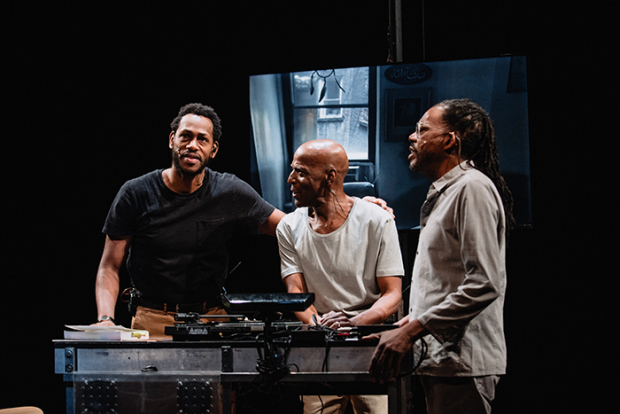Flipping to The B-Side to Resurrect Fading African-American Folklore
The Wooster Group offers a theatrical rendering of the album “Negro Folklore From Texas State Prisons”, released in 1965.

(© Teddy Wolff)
Eric Berryman, the creator and lead performer of The B-Side: "Negro Folklore from Texas State Prisons" A Record Album Interpretation, opens the show with its origin story. He explains how taken he was with the Wooster Group's 2014 production of Early Shaker Spirituals: A Record Album Interpretation (inspired by a 1976 LP recorded by the Sisters of the Shaker Community in Sabbathday Lake, Maine). He describes his chance encounter with that show's director Kate Valk: He was a waiter and she a customer at a Chinese tea house, where he proceeded to pitch her his idea for a companion piece. And he recounts how, at that very moment, all of those percolating thoughts were sitting in his phone in an unsent message that was awaiting the discovery of Valk's email address.
Just as Early Shaker Spirituals added life and dimension to complex American Shaker culture via this buried relic of an album, The B-Side (now running at St. Ann's Warehouse) aims to do the same for the inmates of the segregated agricultural prison farm, who used music to endure their hard labor (the album Negro Folklore From Texas State Prisons was recorded by folklorist Bruce Jackson in 1964). On a basic level, Berryman succeeds in this objective by very literally resurrecting the voices of Johnnie Adams, W.D. "Alec" Alexander, Virgil Asbury, John Bell, Douglas Cannon, James A. Champion, and the dozens of other men heard on the album. Because of Berryman (and Valk, who returns to direct this follow-up to Early Shaker Spirituals), these work songs, gospel numbers, blues tracks, and the sounds of the environment that encased them all will land on ears that they otherwise would not have. But the production as a whole falls short of its designation as an "interpretation," landing more accurately within the less exciting realm of "re-creation."
Berryman stands behind a desk, surgically operating the record player and singing and/or speaking over each track with equal precision. He rarely changes his position, though occasionally he loops around the side of the desk to sit in a chair, offering a clearer view of the low-quality photos of his own apartment featured on the TV screen behind him (very confusing video design by Robert Wuss). His ability to mimic the album's voices and keep its precise pacing (hitting every audible cough and laugh) is undeniably impressive, but remains more a technical feat than an artistic one.
For most of the tracks, Berryman is joined by Jasper McGruder and Philip Moore, whose voices add presence and richness to the performance (kudos to sound designer Eric Sluyter for finding an appropriate balance between the live and recorded audio). But even that fullness of sound loses its vitality as the piece reveals itself as a slow march through both the A-side and B-side of this album, made only more stilted by Berryman's album-cover readings that introduce each song (he intermittently adds further context with readings from Bruce Jackson's book Wake Up Dead Man: Hard Labor and Southern Blues).
We don't get to hear much of the original audio through Berryman, McGruder, and Moore's performances of it, but I can only assume Berryman found the voices he spent so much time mastering to have a power and motion worth theatricalizing. The trio's apt renderings of the album's songs and speeches don't put that in doubt, but, they also don't do much in the way of enhancing any of that power and motion through the "interpretation" we were promised. A live performance may inherently breathe a modicum of life into a dusty record, but I suspect this album can tell a richer story on its own.







